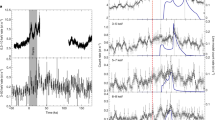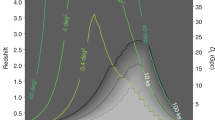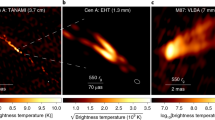Abstract
A RECENT article by Edwards et al.1 suggested that observations of the phase delay suffered by VLF radio waves propagating over large distances in the Earth–ionosphere waveguide revealed the presence of ionization in the night-time lower ionosphere produced by X-rays from the strong X-ray source, Scorpius XR-1. and other weaker sources in the vicinity of the galactic centre. These observations were taken on the 20 kHz transmissions from WWVL, Boulder, recorded in New Zealand.
This is a preview of subscription content, access via your institution
Access options
Subscribe to this journal
Receive 51 print issues and online access
$199.00 per year
only $3.90 per issue
Buy this article
- Purchase on Springer Link
- Instant access to full article PDF
Prices may be subject to local taxes which are calculated during checkout
Similar content being viewed by others
References
Edwards, P. J., Burtt, G. J., and Knox, F., Nature, 222, 1053 (1969).
Burgess, B., Proc. Inst. Elec. Eng. (in the press).
Gould, R. J., Amer. J. Phys., 35, 376 (1967).
Swider, W., Cont. Proc. DRTE, Ottawa, 29 (1967).
Cook, G. E., Nature, 222, 969 (1969).
Radicella, S. M., J. Atmos. Terr. Phys., 30, 1745 (1968).
Author information
Authors and Affiliations
Rights and permissions
About this article
Cite this article
BURGESS, B., JONES, T. Search for the Effect of Stellar X-rays on the Night-time Lower Ionosphere. Nature 224, 680–681 (1969). https://doi.org/10.1038/224680a0
Received:
Issue Date:
DOI: https://doi.org/10.1038/224680a0
This article is cited by
-
Geomagnetic effect associated with X-ray flare from Sco X-1
Nature (1975)
-
Possibility of continuous monitoring of celestial X-ray sources through their ionization effects in the nocturnal D-region ionosphere
Astrophysics and Space Science (1972)
-
Night-time Anomalies in Very Low Frequency Propagation produced by a Galactic X-ray Source at Centaurus
Nature (1970)
Comments
By submitting a comment you agree to abide by our Terms and Community Guidelines. If you find something abusive or that does not comply with our terms or guidelines please flag it as inappropriate.



